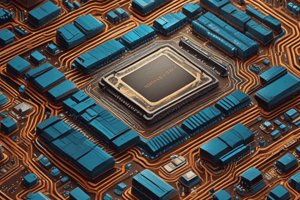Podcast
Questions and Answers
What is a microprocessor and its role in a computing system?
What is a microprocessor and its role in a computing system?
A microprocessor is an integrated circuit that performs all the operations of a central processing unit (CPU).
What company was the first to successfully integrate all the components of a processor onto a single integrated circuit?
What company was the first to successfully integrate all the components of a processor onto a single integrated circuit?
Intel
The Intel 4004 microprocessor was the first microprocessor ever made.
The Intel 4004 microprocessor was the first microprocessor ever made.
True (A)
What is the primary purpose of an interrupt in a computer system?
What is the primary purpose of an interrupt in a computer system?
What are the two main categories of interrupts?
What are the two main categories of interrupts?
What does NMI stand for in the context of computer interrupts and what is its significance?
What does NMI stand for in the context of computer interrupts and what is its significance?
Software interrupts are caused by exceptional conditions or instructions within a program.
Software interrupts are caused by exceptional conditions or instructions within a program.
The Intel 4004 microprocessor was capable of processing 16 bits.
The Intel 4004 microprocessor was capable of processing 16 bits.
What is the main solution discussed to lower power consumption and increase computational power in modern CPUs?
What is the main solution discussed to lower power consumption and increase computational power in modern CPUs?
What is the purpose of the interrupt vector table in a computer system?
What is the purpose of the interrupt vector table in a computer system?
What is the main purpose of the INT N instruction in assembly language?
What is the main purpose of the INT N instruction in assembly language?
What is the significance of the AH register when using the INT 21H interrupt?
What is the significance of the AH register when using the INT 21H interrupt?
Which instruction is generally used to send a byte of data to a specific output port?
Which instruction is generally used to send a byte of data to a specific output port?
Describe two major techniques for handling input/output (I/O) operations in computer systems.
Describe two major techniques for handling input/output (I/O) operations in computer systems.
Programmed I/O is generally considered more efficient than interrupt-driven I/O.
Programmed I/O is generally considered more efficient than interrupt-driven I/O.
What is the main idea behind diverting an interrupt?
What is the main idea behind diverting an interrupt?
What does the acronym 'C.I' commonly refer to in the context of computer systems?
What does the acronym 'C.I' commonly refer to in the context of computer systems?
In the context of programmed I/O, 'polling' refers to the CPU constantly checking the status of peripheral devices to see if they are ready to exchange data.
In the context of programmed I/O, 'polling' refers to the CPU constantly checking the status of peripheral devices to see if they are ready to exchange data.
What is the primary advantage of interrupt-driven I/O over programmed I/O?
What is the primary advantage of interrupt-driven I/O over programmed I/O?
In the context of input/output (I/O) operations, what is the difference between an 'input port' and an 'output port'?
In the context of input/output (I/O) operations, what is the difference between an 'input port' and an 'output port'?
What is the role of the 'control port' in the context of input/output (I/O) operations?
What is the role of the 'control port' in the context of input/output (I/O) operations?
Describe two main benefits of using interrupt-driven I/O in computer systems.
Describe two main benefits of using interrupt-driven I/O in computer systems.
Explain the significance of the 'status port' in the context of input/output operations.
Explain the significance of the 'status port' in the context of input/output operations.
Flashcards
Microprocessor
Microprocessor
An integrated circuit that performs all the functions of a central processing unit (CPU).
Intel 4004
Intel 4004
The first microprocessor, released by Intel in 1971. It was a 4-bit processor with limited capabilities but a revolutionary technology.
Interrupt
Interrupt
An event that interrupts the normal execution of a program, causing it to temporarily switch to a specific routine to handle the interruption.
Interrupt routine
Interrupt routine
Signup and view all the flashcards
Material Interrupts
Material Interrupts
Signup and view all the flashcards
Non-Maskable Interrupt (NMI)
Non-Maskable Interrupt (NMI)
Signup and view all the flashcards
Software Interrupts
Software Interrupts
Signup and view all the flashcards
Interrupt Vector Table
Interrupt Vector Table
Signup and view all the flashcards
Diverting an Interrupt
Diverting an Interrupt
Signup and view all the flashcards
Interrupt 21H Services
Interrupt 21H Services
Signup and view all the flashcards
Input/Output (I/O) Operations
Input/Output (I/O) Operations
Signup and view all the flashcards
Input/Output (I/O) Interface Circuit
Input/Output (I/O) Interface Circuit
Signup and view all the flashcards
I/O Ports
I/O Ports
Signup and view all the flashcards
IN
IN
Signup and view all the flashcards
OUT
OUT
Signup and view all the flashcards
IN AL, Addr
IN AL, Addr
Signup and view all the flashcards
OUT Adr, AL
OUT Adr, AL
Signup and view all the flashcards
Interrupt-driven I/O
Interrupt-driven I/O
Signup and view all the flashcards
Polled I/O
Polled I/O
Signup and view all the flashcards
Direct Memory Access (DMA)
Direct Memory Access (DMA)
Signup and view all the flashcards
DMA Controller
DMA Controller
Signup and view all the flashcards
Serial I/O
Serial I/O
Signup and view all the flashcards
Parallel I/O
Parallel I/O
Signup and view all the flashcards
Full Duplex
Full Duplex
Signup and view all the flashcards
Half Duplex
Half Duplex
Signup and view all the flashcards
Simplex
Simplex
Signup and view all the flashcards
Asynchronous Communication
Asynchronous Communication
Signup and view all the flashcards
Synchronous Communication
Synchronous Communication
Signup and view all the flashcards
Study Notes
Architecture of Computers 2, L2ING, Chapter 4: Interruptions & I/O
- Microprocessor Definition: A microprocessor is an integrated circuit capable of executing all the operations of a central processing unit.
- Intel's 1971 Achievement: In 1971, Intel successfully placed all the components of a processor onto a single integrated circuit, creating the first microprocessor.
- Key Figures: The development was a collaborative effort, notably by Marcian Ted Hoff and Federico Faggin.
- First Intel Microprocessor: The Intel® 4004 microprocessor was introduced in 1971.
- Historical Microprocessor Characteristics: The Intel 4004 had 2300 transistors and worked with 4-bit calculations, 16 registers with 4 bits of data and 46 instructions.
- Processor Data Bus Width: The 4004's data bus was 4 bits wide.
- Clock Speed: The processor had a clock speed of 108 kHz.
- Microprocessor Size (4004): The chip's dimensions were 3.81mm by 2.79mm, equalling 10.62mm²
- Cost: Intel sold the 4004 and its rights for US$ 60,000 to its client, the Japanese company Busicom.
- Evolution of Microprocessors: The provided table shows a chronological list of Intel microprocessors with increasing clock speeds and transistor counts.
Historical Evolution
- Timeline and Specifications: Displays a comprehensive table of Intel processor releases, noting their respective dates, model names, transistor counts, manufacturing process nodes (fineness of engraving), and clock frequencies.
Interruptions
- Asynchronous Event: It's a temporary suspension of the currently running program.
- Branching to Subprogram: Causes the processor to branch to a specific subroutine (interrupt routine) to handle the interruption.
- Return Instruction (IRET): Essential to return and resume the main program's execution.
Interruption Classes
- Material Interrupts (IRQ): Caused by external events from peripherals such as input devices, output devices, that trigger them via electrical signals.
- Non-Maskable Interrupt (NMI): Not influenced by the IF flag.
- Interrupt Request (INTR): Its execution depends on the IF flag.
- Software Interrupts: Triggered by special instructions within the microprocessor's instruction set, or by abnormal or logical conditions.
- Vectorized Interrupts (x86 Intel): x86 Intel microprocessors use a vectorized approach for interrupt handling. The physical addresses of the interrupt handlers are saved in a table.
- Interrupt Vector Table: A system table containing addresses (CS:IP) to execute every possible interrupt handler.
- Reserved Vectors: The first 5 vectors are reserved by Intel for specific uses. Others are assigned by the operating system.
- User Space: The remaining, empty vectors can be used by the operating system or the user.
Interrupt 21H
- System Interrupt: A significant interrupt routine offering various services.
- AH Register: You must first set the function number in the AH register, before directing the interrupt.
I/O Operations (Inputs/Outputs)
- Input/Output (I/O) Operations: Enable data exchange between the microprocessor and peripheral devices through interface circuits.
- Interface Circuit: A device-specific circuit responsible for managing data transmission between a microprocessor and a peripheral device and controlling the data transfer.
- Characteristics of ICs: ICs are usually programmable and intelligent, capable of supporting various operation modes.
I/O Types
- Programmed I/O (Polling): The microprocessor continuously interrogates the status of an interface to detect when it is ready for a given operation.
- Interrupts: The interface signals the microprocessor when it's ready for data transfer.
Specific I/O Instructions
- IN: Instruction for reading data from a port, into registers, such as AL or AX.
- OUT: Instruction for writing data from a register into a port.
Example I/O Operations
- Examples and Solutions: Some programming examples in assembly language are given to illustrate diverse I/O operations, such as reading an input from the keyboard and writing to a display.
Studying That Suits You
Use AI to generate personalized quizzes and flashcards to suit your learning preferences.




